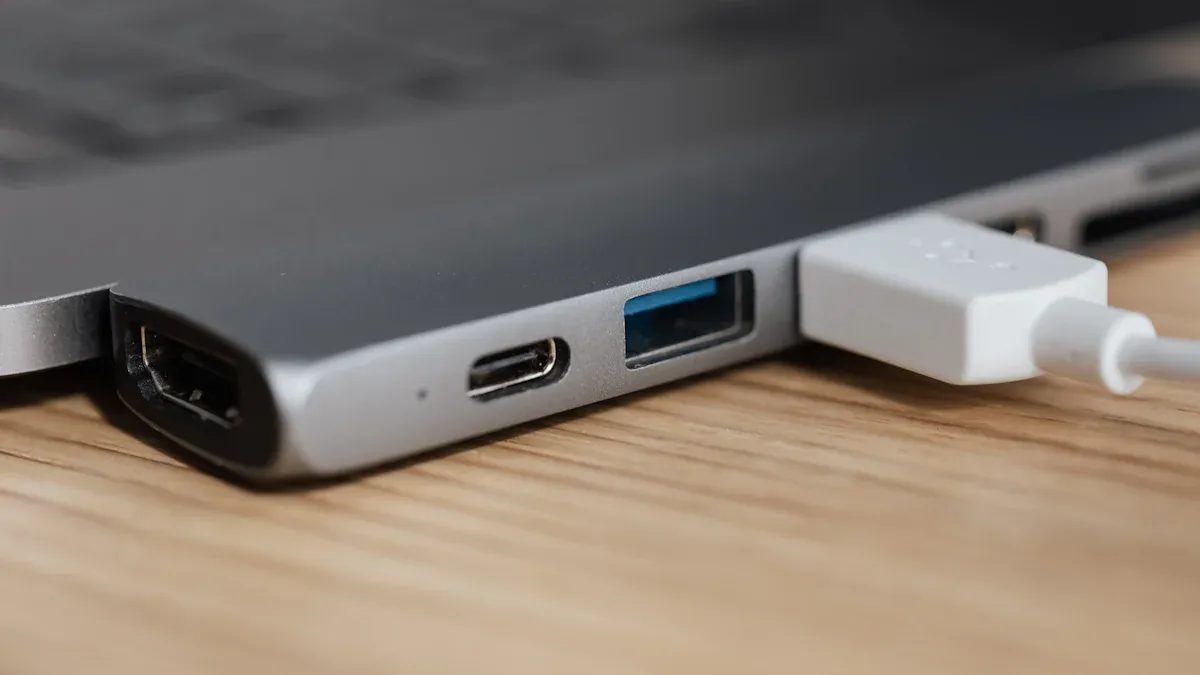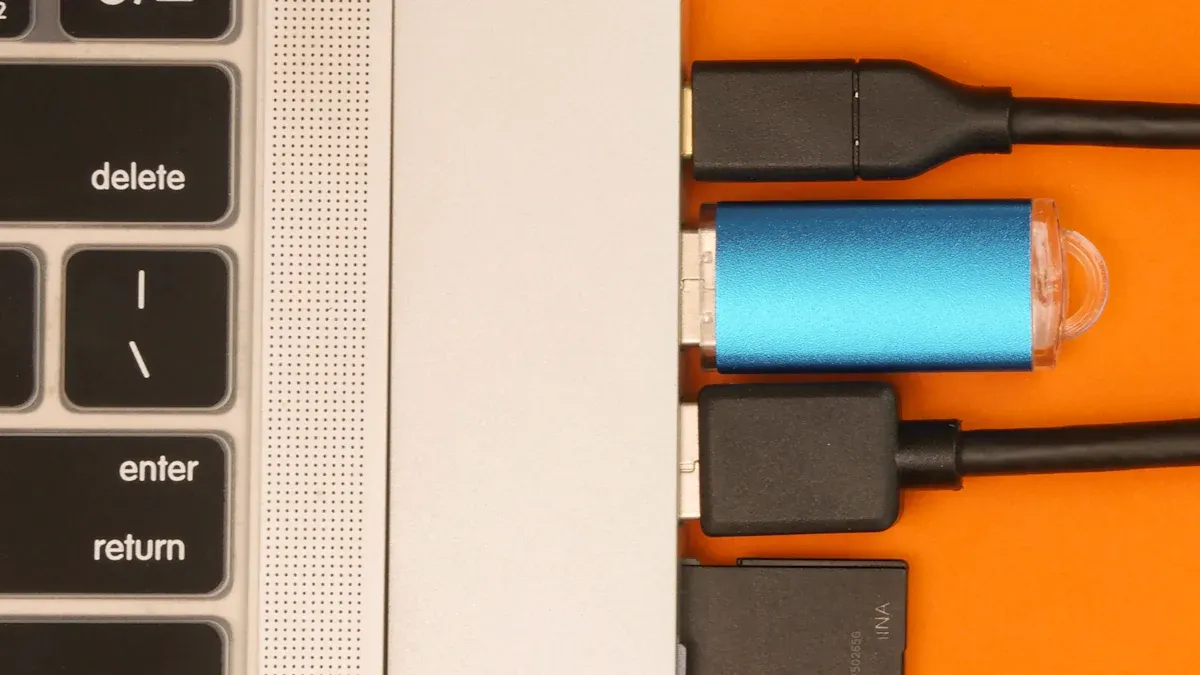Upgrading to a USB-C charger plug transforms your charging experience. With USB-C, your Apple devices charge faster and transfer data more efficiently. For instance, an iPad Pro can reach 33% in just 30 minutes with a USB-C charger, compared to only 10% with USB-A. By making the switch to USB-C, you embrace cutting-edge technology while simplifying your setup and preparing for future Apple innovations.
Why USB-C Charger Plug is Superior
Faster charging speeds for iPhone and other Apple devices
Switching to a USB-C charger plug revolutionizes how you charge your iPhone and other Apple devices. With USB-C, you can achieve fast charging speeds that were previously unattainable. For example:
– A USB-C charger can power your device from 0% to 50% in just 30 minutes when paired with a 30-watt charger.
– While Lightning connectors can also reach 50% in 30 minutes, USB-C surpasses them with its higher power delivery capabilities.
This means you spend less time tethered to a wall outlet and more time enjoying your iPhone or iPad. Whether you’re charging an iPhone 15 or preparing for the upcoming iPhone 16, USB-C ensures you stay ahead with fast and efficient charging.
Tip: Upgrade to a USB-C charger plug to experience the benefits of faster charging speeds and reduced downtime.
Enhanced data transfer rates for seamless file sharing
USB-C doesn’t just excel at charging—it also transforms how you transfer data. With USB-C, you can move files between devices at lightning-fast speeds. Here’s a breakdown of the impressive data transfer rates:
1. USB4 Gen 2×2 supports speeds of up to 20Gbps.
2. Thunderbolt technology reaches up to 40Gbps.
3. The latest USB standard can even achieve 80Gbps.
To put this into perspective, transferring a 5GB file via Thunderbolt takes just one second. This makes USB-C ideal for sharing large files, such as high-resolution videos or extensive photo libraries, without delays.
| Technology | Peak Data Transfer Speed | Description |
|---|---|---|
| USB4 | Up to 20Gbps | A significant upgrade from earlier standards. |
| Thunderbolt | Up to 40Gbps | Enables daisy-chaining of multiple devices. |
| USB4 | 10Gbps or 20Gbps | Perfect for high-speed data transfer needs. |
By adopting USB-C, you ensure that your iPhone, iPad, or MacBook can handle even the most demanding data tasks with ease.
Universal compatibility across Apple and non-Apple devices
One of the standout features of USB-C is its universal compatibility. Unlike Lightning connectors, which are exclusive to Apple, USB-C works seamlessly across a wide range of devices. This includes not only Apple products like the iPhone 14, iPhone 15, and MacBook but also non-Apple devices.
Here’s a quick comparison of USB-C’s compatibility:
| Feature | USB-C Standard | Apple Devices Compatibility | Non-Apple Devices Compatibility |
|---|---|---|---|
| Power Delivery | Up to 240W | Yes | Yes |
| Bi-directional Charging | Yes | Yes | Yes |
| Data Transfer | Yes | Yes | Yes |
| Video Output | Yes | Yes | Yes |
| Connector Design | Reversible | Yes | Yes |
This universal standard simplifies your charging setup by reducing the need for multiple cables. It also aligns with the European Union’s push for a common charging standard, making USB-C the go-to choice for the future.
Note: By switching to USB-C, you not only future-proof your devices but also contribute to a more sustainable and eco-friendly tech ecosystem.
Compatibility of USB-C with Apple Devices
Apple devices that support USB-C (iPhone, iPad, MacBook)
Apple has steadily embraced USB-C across its product lineup, making it the standard for many of its devices. If you’re wondering which Apple devices support USB-C, here’s a quick overview:
– iPhones: Starting with the iPhone 15 series, Apple introduced USB-C, replacing the Lightning connector.
– iPads: Models like the iPad Pro, iPad Air (4th generation and later), and the 10th-generation iPad feature USB-C ports.
– MacBooks: All modern MacBook models, including the MacBook Air and MacBook Pro, come equipped with USB-C ports for charging and data transfer.
For detailed specifications, platforms like EveryMac.com provide comprehensive information about Apple devices, including their USB-C compatibility. This shift to USB-C ensures faster charging, seamless data transfer, and a universal standard across Apple’s ecosystem.
Tip: If you own an iPhone 15, iPad Pro, or a MacBook, upgrading to a USB-C charger plug will unlock the full potential of your device.
Solutions for older Apple devices without USB-C
If you own older Apple devices that rely on Lightning connectors, you might wonder how to adapt to the USB-C era. Thankfully, there are practical solutions to bridge the gap:
1. USB-C to Lightning cables: These cables allow you to connect your older iPhones or iPads to USB-C chargers.
2. Adapters: USB-C to Lightning adapters enable you to use USB-C accessories with your Lightning devices.
3. Dual-port chargers: Some chargers feature both USB-C and USB-A ports, letting you charge both new and old devices simultaneously.
These options ensure that you don’t have to replace your older devices immediately. Instead, you can gradually transition to USB-C while still enjoying the benefits of faster charging and universal compatibility.
Note: Investing in high-quality adapters and cables ensures durability and optimal performance for your devices.
Adapting non-USB-C devices with cost-effective accessories
USB-C’s universal compatibility extends beyond Apple devices, making it a versatile choice for your tech setup. If you own non-USB-C devices, you can still integrate them into your USB-C ecosystem with affordable accessories:
– USB-C hubs: These hubs expand your USB-C port into multiple connections, including USB-A, HDMI, and SD card slots.
– USB-C to USB-A adapters: These adapters let you connect older peripherals, such as external hard drives or printers, to your USB-C devices.
– Multi-device chargers: Chargers with multiple ports, including USB-C and USB-A, allow you to power all your devices with a single plug.
These accessories simplify your setup and reduce cable clutter, making your workspace more organized and efficient. By adopting USB-C, you future-proof your charging and connectivity needs while maintaining compatibility with your existing devices.
Callout: Switching to USB-C doesn’t mean abandoning your current devices. With the right accessories, you can enjoy the best of both worlds.
Benefits of Switching to USB-C
Reduced cable clutter with a single universal standard
Switching to USB-C simplifies your charging setup by reducing the need for multiple cables. With USB-C, you can use one cable for all your devices, including your iPhone, iPad, and MacBook. This eliminates the hassle of managing different charging cables for Lightning and USB-A ports. Imagine the convenience of carrying just one USB-C to USB-C cable for all your charging needs.
USB-C’s universal compatibility also means fewer cables cluttering your workspace or travel bag. You no longer need to worry about finding the right cable for each device. This streamlined approach not only saves time but also creates a cleaner, more organized environment.
Tip: Upgrade to USB-C accessories to enjoy a clutter-free and efficient charging experience.
Future-proofing your charging setup for upcoming Apple devices
USB-C is the future of charging technology. Apple has already adopted USB-C for its latest devices, including the iPhone 15 and iPad Pro. By upgrading to USB-C, you prepare yourself for the next wave of Apple innovations.
The USB market is growing rapidly, with a projected CAGR of 34.4% from 2022 to 2027. This growth is driven by consumer demand for faster and more efficient charging solutions. The USB Promoter Group has also announced an upgraded USB 4 standard with speeds of up to 80 Gbps. Additionally, the European Union’s decision to standardize USB-C as the common charging standard by 2024 ensures its longevity.
By adopting USB-C now, you stay ahead of the curve and avoid the need for frequent upgrades in the future.
Eco-friendly benefits of adopting USB-C
Switching to USB-C isn’t just convenient—it’s also better for the environment. Manufacturers are moving toward sustainable materials and adhering to regulations like RoHS, which limit hazardous substances in products. Over 70% of consumers now prioritize sustainability when purchasing electronics, and USB-C aligns with this trend.
| Evidence Type | Description |
|---|---|
| Material Compliance | Manufacturers use eco-friendly materials and comply with environmental laws. |
| Consumer Preferences | Most buyers prefer sustainable and recyclable charging solutions. |
| Recycling Partnerships | Companies collaborate with recyclers to reduce e-waste and recover materials. |
By reducing the need for multiple cables and adapters, USB-C minimizes electronic waste. Its universal charging capability also encourages responsible consumption. When you switch to USB-C, you contribute to a greener planet while enjoying fast charging and seamless connectivity.
Callout: Make the eco-friendly choice today by upgrading to USB-C charging solutions.
Switching to a USB-C charger plug transforms how you power and connect your devices. You’ll enjoy faster charging, better data transfer, and universal compatibility. Say goodbye to Lightning cables and embrace a single standard that works across your iPhone, iPad, and MacBook. The European Union estimates this shift could save €250 million annually and reduce 11,000 tons of e-waste. By making the switch to USB-C, you simplify your setup, reduce clutter, and prepare for future Apple innovations. Upgrade today for a seamless and efficient experience with your iPhone 15 and beyond.
FAQ
1. Why should you switch to USB-C if you already have Lightning cables?
USB-C offers faster charging, better data transfer, and universal compatibility. It reduces cable clutter and prepares you for future Apple devices. Switching ensures a seamless and efficient experience.
Tip: Upgrading to USB-C now saves you from frequent upgrades later.
2. Can you still use your old Lightning accessories with USB-C devices?
Yes, you can! Use USB-C to Lightning adapters or dual-port chargers to connect your older accessories. These cost-effective solutions ensure compatibility without replacing your existing devices.
3. Is USB-C durable compared to Lightning connectors?
Absolutely! USB-C connectors are designed for durability and can withstand up to 10,000 insertion cycles. This makes them a reliable choice for long-term use with your devices.
Note: Investing in high-quality USB-C cables ensures even greater longevity and performance.



